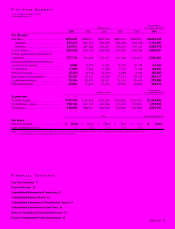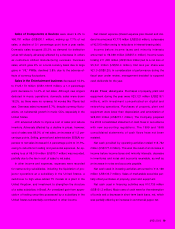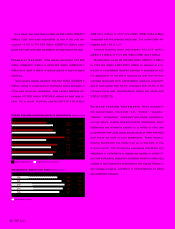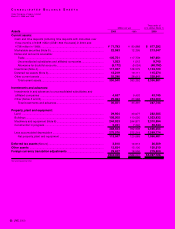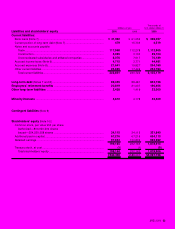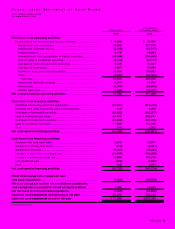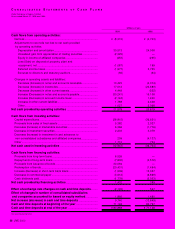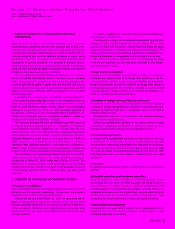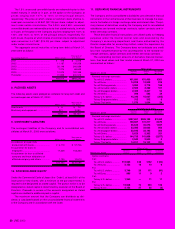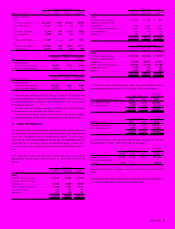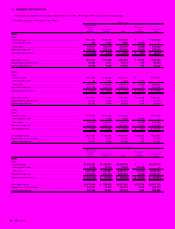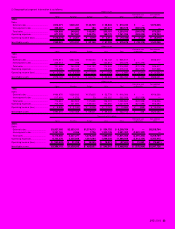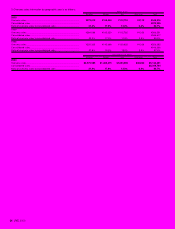JVC 2000 Annual Report Download - page 29
Download and view the complete annual report
Please find page 29 of the 2000 JVC annual report below. You can navigate through the pages in the report by either clicking on the pages listed below, or by using the keyword search tool below to find specific information within the annual report.
JVC 2000 27
1. BASIS OF PRESENTING CONSOLIDATED FINANCIAL
STATEMENTS
Victor Company of Japan, Limited (the “Company”) and its consoli-
dated domestic subsidiaries maintain their accounts and records in ac-
cordance with the provisions set forth in the Japanese Commercial
Code and the Securities and Exchange Law and in conformity with ac-
counting principles and practices generally accepted in Japan, which
are different from the accounting and disclosure requirements of
International Accounting Standards. The accounts of overseas consoli-
dated subsidiaries are based on their accounting records maintained in
conformity with generally accepted accounting principles and practices
prevailing in the respective countries of domicile.
The accompanying consolidated financial statements are a transla-
tion of the audited consolidated financial statements of the Company
which were prepared in accordance with accounting principles and
practices generally accepted in Japan from the accounts and records
maintained by the Company and its consolidated subsidiaries and were
filed with the Ministry of Finance (“MOF”) as required by the Securities
and Exchange Law.
In preparing the accompanying consolidated financial statements,
certain reclassifications have been made in the consolidated financial
statements issued domestically in order to present them in a form
which is more familiar to readers outside Japan. The consolidated
statements of cash flows for 1999 and 1998 have been prepared for
the purpose of inclusion in the consolidated financial statements, al-
though such statements were not customarily prepared in Japan and
not required to be filed with MOF prior to 2000.
The Company prepared the 2000 consolidated cash flow statement
as required by and in accordance with the “Standards for Preparation
of Consolidated Cash Flow Statements, etc.” effective from the year
ended March 31, 2000. The 1999 and 1998 consolidated statements
of cash flows have not been restated. Significant differences in the con-
solidated statement of cash flows for 2000 and those for 1999 and
1998 include the use of pretax income in 2000 instead of net loss in
1999 and 1998, additional disclosure in cash flows from operating ac-
tivities in 2000 of interest expense, income tax expense, interest and
dividend income, interest and dividend received and income taxes paid.
The translation of the Japanese yen amounts into U.S. dollars are in-
cluded solely for the convenience of the reader, using the prevailing ex-
change rate at March 31, 2000, which was ¥106 to U.S.$1.00. The
convenience translations should not be construed as representations
that the Japanese yen amounts have been, could have been, or could
in the future be, converted into U.S. dollars at this or any other rate of
exchange.
2. SUMMARY OF SIGNIFICANT ACCOUNTING POLICIES
Principles of consolidation
The consolidated financial statements include the accounts of the
Company and its significant subsidiaries. All significant intercompany
transactions and accounts have been eliminated.
Effective for the year ended March 31, 2000, all companies are re-
quired to consolidate all significant investees which are controlled
through substantial ownership of majority voting rights or existence of
certain conditions. Previously, only majority-owned companies were
consolidated. The prior years’ consolidated financial statements have
not been restated.
The effect of applying this rule to the Company’s consolidated finan-
cial statements was immaterial.
Investments in certain unconsolidated subsidiaries and affiliated
companies (20% to 50% owned and certain others 15% to 20%
owned) are, with minor exceptions, stated at their underlying net equity
value after elimination of unrealized intercompany profits and losses. The
Company’s investments in its remaining subsidiaries and affiliated com-
panies are immaterial in the aggregate, and are stated at cost or less.
The differences between acquisition cost and underlying net equity
at the time of acquisition are generally being amortized on the straight-
line method over five years.
Foreign currency translation
Current assets and liabilities denominated in foreign currencies are
translated into Japanese yen at exchange rates prevailing at the bal-
ance sheet dates, and non-current assets and liabilities denominated in
foreign currencies are translated at historical exchange rates. Resulting
exchange gains or losses are credited or charged to income for the
respective periods. Foreign currency items with forward exchange con-
tracts are translated at the contracted rates.
Translation of foreign currency financial statements
In accordance with the Accounting Standards for Foreign Currency
Translations, assets and liabilities are translated at exchange rates pre-
vailing at the balance sheet dates. Stockholders’ equity is translated at
historical exchange rates.
Revenue and expenses are translated at the average exchange
rates during the respective years.
Differences resulting from translation of the balance sheet of foreign
consolidated subsidiaries are debited or credited to “foreign currency
translation adjustments” in the accompanying balance sheets.
Cash and cash equivalents
In preparing the consolidated statement of cash flows for the year
ended March 31, 2000, cash on hand, readily available deposits
and short-term highly liquid investments with maturities of not exceed-
ing three months at the time of purchase are considered to be cash
and cash equivalents. Consolidated statements of cash flows for 1999
and 1998 used cash and time deposits instead of cash and cash
equivalents.
Inventories
Inventories are stated at cost, which is determined by the average cost
method.
Marketable securities and investment securities
Securities quoted on stock exchanges are stated at the lower of mov-
ing average cost or market. All other securities are stated at cost or
less, reflecting write-downs based on significant impairment of the
underlying equity, if not considered recoverable. Securities held by the
consolidated subsidiaries in the United States are accounted for based
on the Statement of Financial Accounting Standards No. 115,
Accounting for Certain Investments in Debts and Equity Securities.
Property, plant and equipment
Property, plant and equipment is stated at cost. Depreciation is com-
puted primarily by the declining-balance method based on the
estimated useful lives of the assets.
NOTES TO CONSOLIDATED FINANCIAL STATEMENTS
Victor Company of Japan, Limited
Years ended March 31, 2000, 1999 and 1998


